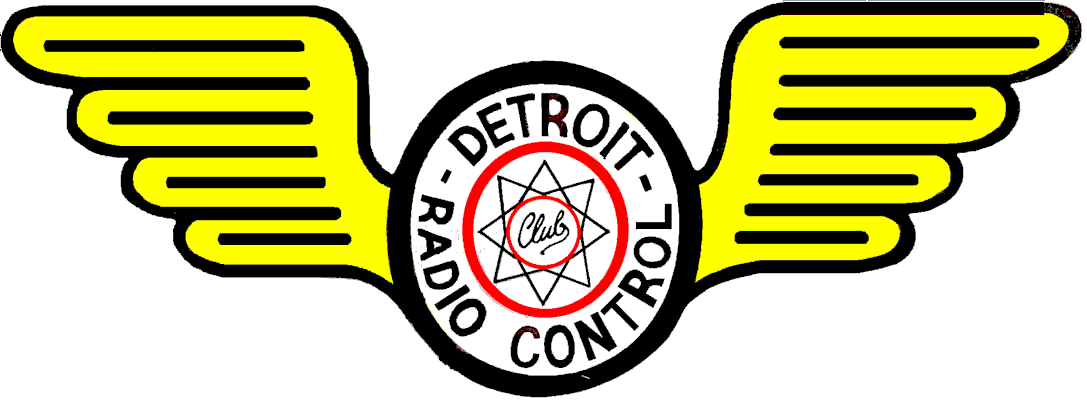The Radio Control Club of Detroit
An AMA Gold Leader Club |

The Radio Control Club of Detroit
|
 |
|---|
| AMA Chapter # 368 | An AMA Charter Club Since 1953 |
IMAA Chapter #206 |
Schedule |
|||||||||
Events Only |
News Archive |
RCCD – 2012 Scratch Build Project
Tips & Input from Participants
Send any you would like to share to Iceman
|
Updated 12/11/11: Q1. I have seen different types of push rods. Which type would you recommend? Do you like a steel rod routed through a plastic casing which would be glued to the plane frame? Do you have any idea for minimum length? Q4. Is there a special size of control horns needed to correctly build this plane? Q5. What would be the dimensions of the Landing gear on the sample plane brought to the meeting? [mounting width at plane] Q6. Do you have a recommended landing gear and tailwheel assembly for the All-Star 60. Getting to the point where I need to drill holes and install "T" nuts. Q8. (Actually an observation) Hi Pete, I just put my wings together. I got to the point where I had cut the six ribs and was juggling those, together with the dihedral brace, plus spacing the brace at the bottom to leave room for sheeting etc and I thought I'd try something different. I flipped the wings over and tack glued the bottom center sheeting in place, making sure I glued the ribs to the bottom sheet. THEN I turned it all right side up and set the dihedral angle etc. MINUS the brace. I then glued the center joint. While that was all weighted and clamped I dropped the center brace in from above, glued and clamped it and then thoroughly re-glued all the bottom sheet joints. Benefits I saw were as follows:
Top sheets are now installed and drying, so other than the fiberglass center reinforcement, my wing is just about done! If I was to do it over again, I think I would partially cut the ribs for the brace (halfway from below), remove the 1/8" half section, then glue on the bottom sheeting. When dry I would finish cutting the ribs. This would hold them in place while the sheeting was applied but would not create an awkward cleanup operation at the bottom of the rib where it was glued to the sheet. It worked for me. How about you get one of the guys to try it out and see what you think? A8. That's what's great about this hobby. There are different ways of obtaining the same results. Your idea sound good and obviously worked for you. You even had another way to accomplish the same thing as stated in your last paragraph. I bet, if we talked to another builder, he would have a fourth way of doing the same thing. Thanks again for your input. Q9. When drilling the holes for the servo wires in the top of the wing sheeting, try not to lose the wooden "slug" down the hole! It's a PITA to get out because that section is enclosed except for the servo wire tubes. Don't ask me how I know!!! A9. I start off by laying out the location and the hole size I want (approx. 3/4" dia.). I usually drill a smaller hole, and enlarge it by first using a exacto knife cutting the hole larger with small cuts leaving small shaving. I then finish the hole by sanding the hole round, again leaving small dust shavings. The final step is to vacuum out the dust through the holes after both holes are in the top sheeting, thus no PITA. I won't ask you, how I know, Q10. I was reading about building the four star 60 kit and modifications others have tried. Have you heard this one? From an RCGroups thread ... "the single most important "mod" to the 4-star is to drop the horizontal stab to the bottom of the fuse. The 4-star is a great flying sport plane, but exhibits a rather huge downward pitching tendency with rudder input. Dropping the stab to the bottom corrects this". Does this sound like a good thing to do with the all star 60 kit? A10. I have not heard this one, but have never built a 4 Star before. However, I can believe the pitch to wheels in knife-edge flight. This is not uncommon for a low-wing plane. Conversely the Stik pulls to the "canopy" in knife-edge flight - common for a high-wing plane. Q11. The instructions suggest a starting CG point at 25% of chord, including the aileron? Is this the aileron at it's widest point, ie near the wing root. The chord tapers by more than an inch towards the tips. Same goes for the 5/8" up and down travel - widest point again? A11. The simple answer is to calculate the CG at the midway point of the aileron length (33" divided in half) or 16 -1/2" from the outer edge of the aileron . Measure your wing cord at that point and 25 percent of the wing cord including the aileron is the starting CG point. This works out to be close to the CG shown on the original plans. As for the control surface movements (5/8" up and 5/8" down for the aileron), I assume it is also at the midway point of the aileron. The original instructions of the 4 star 60 reads as follows: "The control surface movements listed here are recommended for the first flights. These movements will provide the model with a fair degree of aerobatic capability if it is balanced correctly. Test flights may indicate a need for slightly more or less movement depending on individual model performance and personal preference."
|
njh